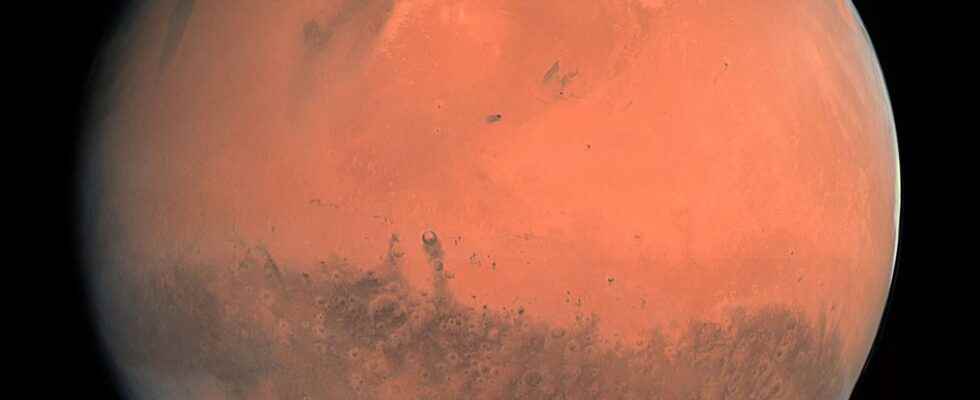The past existence of liquid water on the surface of Mars, partly due to the presence of a magnetic field, is well known today, but the causes of the disappearance of this protective shield about 4 billion years ago years remain obscure. By recreating the conditions prevailing in the Martian core, a Franco-Japanese team of researchers suggests that it is its composition which would have, over time, brought about the cessation of the convective phenomena at the origin of a magnetic field.
You will also be interested
[EN VIDÉO] Solar wind: the Earth protected by its magnetic field Storms from the Sun hurl high-energy particles into space that astronauts can see when their eyes are closed. If they don’t reach us, it’s because the Earth’s magnetic field protects us from the solar wind. Discover in video how this amazing shield works.
On Earth, it is a protective shield for life: the magnetic field protects us from interplanetary space, especially from solar wind (flow of charged particles) that would break the very structure of our DNA and would erode theatmosphere. On Mars, it is believed to have played a major role in the existence ofliquid water at the surface, allowing the maintenance of a dense atmosphere; but the Martian magnetic field did not last long, as evidenced by some magnetized rocks bearing traces of the effects of a past magnetic field.
How does a magnetic field work?
The origin of earth’s magnetic field takes place in its core, more particularly in its part liquid composed of a alloy of iron and of nickel. Due to the progressive cooling of the core (causing little by little its solidification), movements of convection are generated in the liquid core, producing what is called thedynamo effect. On Mars, based on various gravitational analyses, it is believed that the core is still mostly liquid ; a team of researchers suggests that it is its composition that would have led to the premature cessation of convective movements there.
Martian core less dense than Earth’s
Based on seismic data recorded by the lander InSight of the Nasa, as well as on the composition of Martian meteorites, we can estimate the internal composition of Mars. Thus, the Martian core appears to have a relatively low density, indicating that it is likely enriched in sulfur and light elements, such ashydrogenmixed with liquid iron.
To simulate the behavior of the Martian core in the laboratory, the scientists based themselves on this estimate: they placed a sample of an alloy of iron, sulfur and hydrogen between two diamonds compressed (to simulate the pressure conditions in the Martian core) and under the radiation of a laser infrared (to simulate the temperature of the Martian core).
Strange behavior in the bowels of Mars…
By observing the sample exposed to the conditions of the Martian X-ray core, the scientists were able to observe the variations of its structure and its composition. And their observations revealed that the alloy of iron, sulfur and hydrogen had a strange behavior: initially homogeneous, the sample separated into two distinct liquids, one enriched in sulfur, the second enriched in hydrogen. . According to scientists, it is this separation between these two liquids which would have caused both the appearance of a magnetic field on Mars, but also its premature disappearance.
The hydrogen-enriched liquid iron phase, less dense than the sulphur-enriched liquid iron phase, would gradually rise above the latter, causing convective movements as it passed. These currents, relatively similar to terrestrial convective currents, would have favored the appearance of a magnetic field in the first phases of the history of Mars, allowing the survival of liquid water on its surface. But these convective currents were not destined to persist: once the two liquid phases were completely separated, there was no longer any engine to generate movements in the core. the magnetic field would then have dissipated, and the Martian atmosphere would then have been exposed to solar radiationabout 4 billion years ago.
Interested in what you just read?
